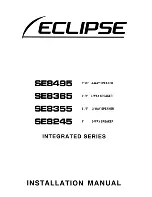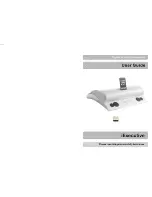
Bass Management Theory). Note from the diagram that for professional use a sep-
arate 6- channel level control box is required between the mix-down deck and the
monitor speakers. This is because few small format mixing consoles have provi-
sions to switch and level-manage a 6-channel audio signal. The simplest and per-
haps best way to accomplish this is to use an external, 5.1 level controller. It is
placed between the outputs of the mix-down deck and the monitor speakers, allow-
ing it to control the playback level while the mix-down deck receives full-level
recording signal.
Another option is to use a consumer, home-theater receiver in place of a profes-
sional level controller. Many of the current generation receivers have separate ana-
log inputs that can be used for directly monitoring your mix from the console. If you
are using unpowered, full-range speakers, then you can utilize the onboard power
amps in the receiver itself to power them. If, on the other hand, you are using self-
powered speakers for the full-range monitors, be sure to pick out a receiver that
has preamp line-level outputs in addition to speaker-level outputs. Be aware that
some inexpensive home theatre receivers disable bass management for the analog
line inputs.
Subwoofer Placement and Setup
A properly set up subwoofer system extends the bass response of the main speak-
ers (Either stereo or 5.1 surround) down into the 30-Hz range, but without exagger-
ating bass response in the room. Improper setup may cause an exaggeration of
bass response in the room, which in turn may cause the engineer to mix in less
bass energy than desired.
There are three basic steps to take to ensure you have a subwoofer operating in
top form: 1) Room treatment; 2) Proper placement of the sub in the room; and 3)
Proper electrical settings. The first step (which is beyond the scope of this manual)
means you should hire a qualified studio acoustical consultant who can identify and
rectify the acoustical shortcomings of your control room. You will hear a lot of talk
about standing waves, flutter, decay time, absorption and reflection, and it may be
expensive, but if you run a commercial recording space, consider it the cost of
doing business. If, of course, you dealt with the necessary room treatment before
purchasing a subwoofer, then you are already in great shape to move forward.
If room treatment is not in your plans, then focus on the other two basic ways to
accomplish proper setup of your subwoofer. These are: 1) via proper subwoofer
placement within the room; and 2) via electrical settings that affect levels, low-pass
filter frequency and phase
Proper Physical Placement of Subwoofer
Just because bass frequencies are largely non-directional does not mean that you
can ignore the subwoofer's placement in the room. If fact, a sub's physical position
in the room in relation to the floor, walls and other surfaces radically influences its
bass response. In a monitoring situation, it is desirable to place the subwoofer so
that it produces the smoothest frequency response at the listening position. In addi-
tion, since the subwoofer's output will interact with the other monitor speakers in
the room, it is important to consider the subwoofer and near-field speakers as a
total system. If you have access to a Real Time Analyzer and a calibration micro-
phone, then setting up the room can be fairly painless. However, it can also be
done with a generic SPL meter, or even your own ears, once you know what to lis-
ten for.
At this stage, you have only the subwoofer operating. Once you find its optimum
position and settings, then it will be time to turn on the complete monitoring system
to see that all components interact properly. What you are attempting to do is find a
place in the room where the subwoofer interacts smoothly with the acoustics to
even out the bass response at the listening position. One novel way to do this is to
reverse the normal position of the subwoofer and listening spot by temporarily mov-
ing the subwoofer to your seat position in front of the console. Then play back pink
noise in the 30 to 80 Hz range or music with robust bass information. Now by mov-
ing the SPL meter (or your ears) around the various potential speaker positions in
the room, you can listen for where the bass sounds the loudest. That is where the
speaker loading would potentially be at its greatest.
Once you find the optimal spot, place the subwoofer at that position and listen to it
from the console position. Even without an SPL meter you can then use stepped
band-pass, pink noise and sine-wave sweeps to evaluate how even the bass
response is. Move the subwoofer around a foot at a time until the bass response is
as even as possible at the listening position. Remember that you do not want any
single frequency to be exaggerated during monitoring, as that will result in the final
music mix having too little bass. One caveat: if your subwoofer's optimum position
is under your console, make sure to protect it from your (and your client's) feet. You
do not want to repeatedly kick holes in the sub….
Finally, go to the next section on setting the level and determining the proper posi-
tion of the phase switch on the subwoofer.
11
12





























